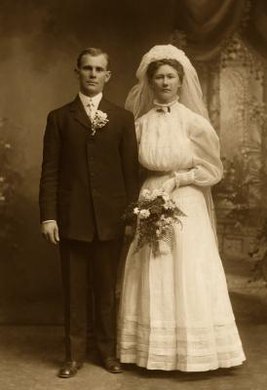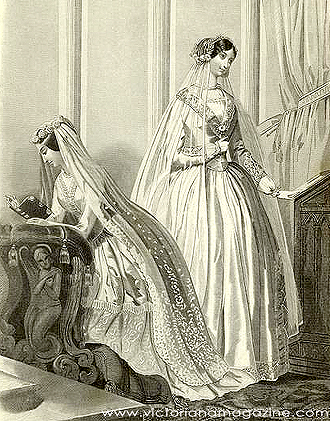License
On the Banns: "If marrying in the Church of England, the couple would “publish the banns.” From his pulpit, the local clergy would announce the upcoming wedding for three consecutive Sundays. If the bride and groom lived in different parishes, the banns were read in both. If there were no objections to their joining, the couple could marry within 90 days of the final call. This was the method that the poorer families used for it cost nothing to have the banns called. Of course, one ran the possibility that an objection would be lodged in a very public manner. If the persons marrying came from separate parishes, the curate of one parish could not solemnize the wedding without a certificate of the other stating the banns had been “thrice called” and no objections had been lodged." (
Jeffers)
On the Common License: "For approximately 10 shillings, a couple could purchase a license from a clergyman. Then the couple could marry in either the parish of the bride or the groom. The common/ordinary license was good for 15 days. The common license could be obtained from any bishop or archbishop. A sworn statement was given that there were no impediments to the marriage. The marriage was to take place within 3 months of the license’s issuance." (
Jeffers)
Dress
On the wedding ring: "The wedding ring was usually a plain gold band with the initials of the couple and the date of their wedding engraved inside" (
Victorian Ceremony)
On the groom's gift: "The groom was also expected to provide "a handsome locket, necklet or other article of jewellery" for the bride to wear on the wedding day. He might present the bridesmaids with lockets or other small gifts such as bracelets, necklaces, rings, pendants, or brooches, often chosen by the bride." (Phegly)*
On early Victorian quality: "The early Victorian wedding dress had a fitted bodice, small waist, and full skirt (over hoops and petticoats.) It was made of organdy, tulle, lace, gauze, silk, linen or cashmere. The veil was a fine gauze, sheer cotton or lace. The reasonable cost of a wedding gown in 1850 was $500, according to
Godey's, with $125 for a veil."
On mid-Victorian wear: "Formal weddings during this period were all white, including the bridesmaid's dresses and veils. Veils were attached to a coronet of flowers, usually orange blossoms for the bride and roses or other in-season flowers for the attendants. The bride's accessories included: short white kid gloves, hanky embroidered with her maiden name initials, silk stockings embroidered up the front, and flat shoes decorated with bows or ribbons [...] Full court trains were now part of the wedding ensemble, as were long veils, a bustle, elegant details and two bodices--a modest one for the wedding and a low one for special occasions." (
LL)
On the material: "In 1851, the Home Circle suggested that morning wedding dresses be made out of plain white muslin or net, or white damask silk with plain sleeves" (Phegly)*
On wearing white: "The white of choice for most brides was not a pure white, however, rather a cream or ivory color which was more flattering to the complexion." (
Ohio State University)
On jewelry: "As for jewelry, diamonds have always been popular. When white dresses were in vogue, pearl and diamond combinations were fashionable. The mid-Victorians had a more extravagant display of wealth, often a diamond tiara for the ceremony." (
LL)
On the bridal bouquet: "The bride's bouquet was typically made of orange blossoms and other white flowers such as camelias, azaleas, or gardenias" (Phegly)*
On the old adage: "Finally, for the bride, you may recall the English rhyme: "Something old, something new, something borrowed, something blue, and a lucky sixpence in your shoe." Something old was often a family heirloom and the bride's link with the past. Something new could be her dress or a gift from the groom. Something borrowed was of real value like a veil or headpiece, and returned to the owner. Something blue was often the garter or an embroidered handkerchief. The touch of blue symbolized faithfulness, while the sixpence ensured future wealth." (
LL)
On mid-Victorian groom's style: "By the mid-Victorian era, frock coats were seldom worn, the morning coat being preferable because of its smarter appearance. Some grooms still wore frock coats, however, and did so with a vest of black cloth, dark gray trousers, a folded cravat of medium color, and lavender gloves stitched in black." (
LL)
On early Victorian groom's style: "In the early Victorian era, the bridegroom wore a frock coat of blue, mulberry or claret, and a flower favor in his lapel. [...] His waistcoat was white, and his trousers of lavender doeskin. Black was out of the question. The best man and groomsmen wore frock coats also, but in a more subdued tone." (
LL)
Bridal party
On entering the country church: "In England, a country bride and her wedding party walked to church on a carpet of blossoms to assure a happy path through life. For the wealthier, a grey horse pulling the wedding carriage was considered good luck" (
Victorian Ceremony)
On bridesmaids: "The bride may act her pleasure in regard to bridesmaids. She may have none; she may have one, two, three, four, six or eight; and it is customary to have but one groomsman"(
Victorian Ceremony)
On bridesmaid duties: "The chief bridesmaid, or maid of honor, was advised to provide support to the bride in the days leading up to the wedding by offering assistnce with shopping, sewing, clothing preparation, dressing and so on, particularly in middle-class households that did not employ a lady's maid to attend to such matters" (Phegly)*
On order procession: "Taking her father's right arm (or the right arm of a brother or whoever was to give her away), the bride proceeded through a double line of bridesmaids into the church to meet her fiance at the altar." (Phegly)*
Guests
On interaction with guests: "In England, the bride also made favors [white ribbon, flowers, lace, and silver leaves] and pinned them on the sleeves and shoulders of the guests as they left the ceremony. Later in the era, even the servants and horses wore flowers, The servant's favors were handmade by the bride and included a special memento if she'd known them from childhood" (
Victorian Ceremony)
On model invitations from The Etiquette of Marriage: "MR AND MRS. SMITH / Request the pleasure / of / MR. and MRS. JONES' / Company at the / Marriage / of their daughter EDITH and / MR. HERBERT WARD / at / St. George's, Hanover Square / On Wednesday, 24th April 1901, at 2 P.M. / and afterwards / at / 100 Grosvenor Street" (Phegly)*
On guest arrival time: "The guests usually arrived by 11:0, followed by bridesmaids and the bride's sister(s) or mother who waited to greet the bride at the church door where she was to be escorted into the church by her father." (Phegly)*
Timeline
On mid-Victorian ideal wedding time: "By the late 1880s, permissible hours were extended until 3:00 p.m." (
Victorian Ceremony)
On mid-Victorian church setting: "In the 1850s, weddings were almost always held in church, and it was customary to use the bride's parish." (
Victorian Ceremony)
On choosing the date: "June has always been the most popular month, for it is named after Juno, Roman goddess of marriage [...] October was an auspicious month, signifying a bountiful harvest. May, however, was considered unlucky. "Marry in May and rue the day," an old proverb goes. But "Marry in September's shine, your living will be rich and fine." (
LL)
On handling costs: "The father of the bride typically bore the main costs of the wedding ceremony and festivities, including any presents for the groom, the decorations for the church, the music, the wedding carriages, and the reception. [...] The father likewise sent his daughter off to her new home with a trousseau. The bride's trousseau included a wardrobe of underclothes, nightgowns, dresses, and other personal items that could also include silver, linen, and household equipment." (Phegly)*
On choosing day of the week: "Popular days for weddings were weekdays rather than weekends [...] Wednesday best day of all" (Phegly)*
On wedding celebrations amongst working class: "Included only immediate family and were typically held in the evening, after work hours. There was a wedding cake and gifts, but these were only from close family and friends and would consist of food or small useful household items." (Phegly)*
Food
On the wedding cake: "Methods were borrowed from French pastry chefs who transformed the cake into an icon of the wedding ceremony adorned with a hard white sugary crust, flowers [...] they were akin to what we would call a fruit cake, a densely packed confection" (Phegly)
On preparing the cake: "The pieces of cake are afterward put up in ornamental paper, generally pink or white, enameled, and tied with bows of silvered paper." (Phegly)
On food: "the food was luncheon fare, including soups, game, and champagne (instead of coffee or tea)" (Phegly)*
* (Phegly): Phegley, Jennifer.
Courtship and Marriage in Victorian England. Santa Barbara, CA: Praeger, 2012. Print.





